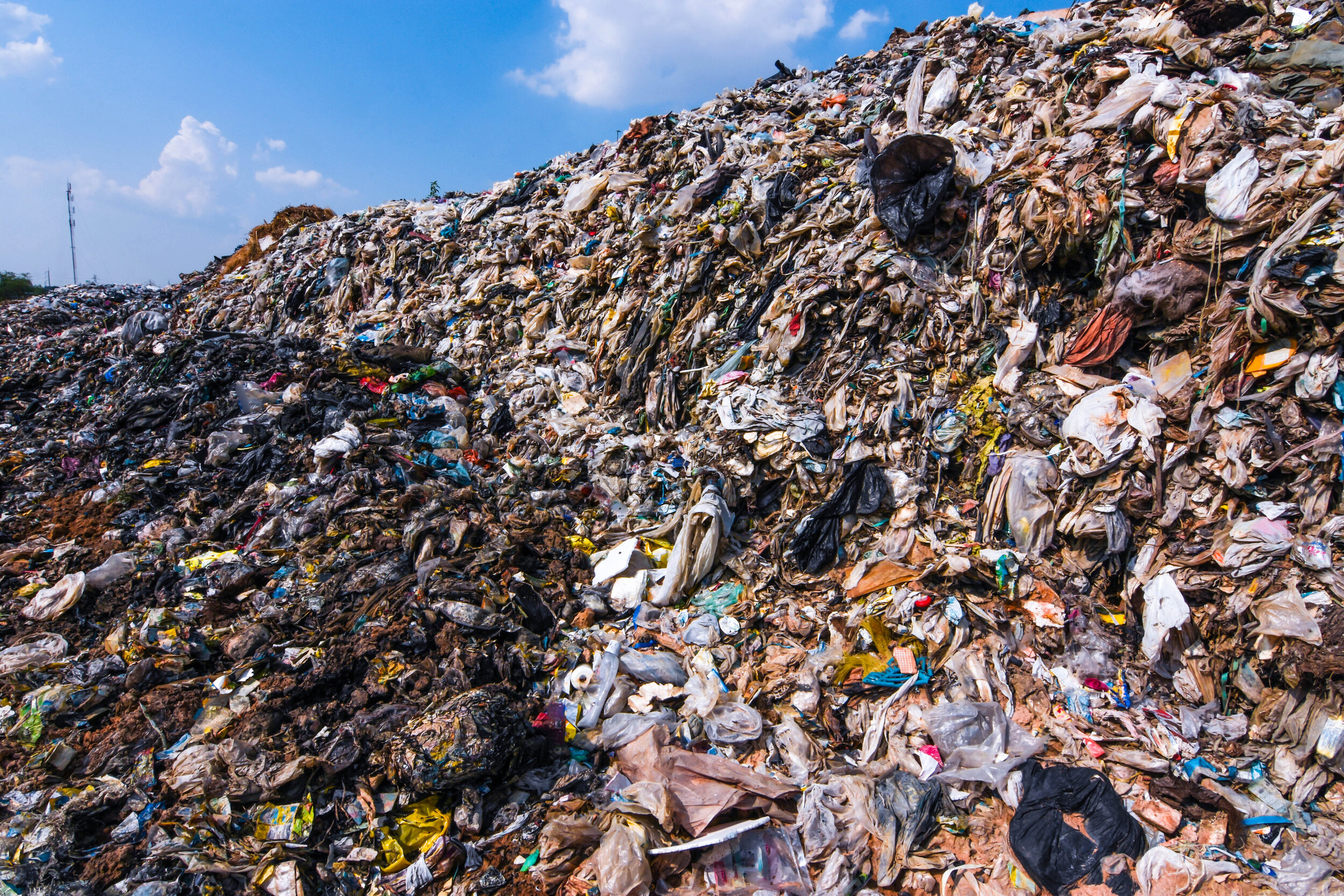Microplastic Pollution and the Fast Fashion Industry
Fast fashion is hard to resist. Low-cost retailers have transformed the way that we shop, enabling customers to keep up with the latest runway trends without breaking the bank. However, fast fashion has a dark side that not many consumers think about: microplastic pollution in our oceans.
A huge percentage of today’s fast fashion is made from cheap, synthetic, non-biodegradable plastic materials such as polyester, nylon, and spandex. The trouble with these fabrics is that when they are washed, they release plastic fibers into the water which are so small that they pass through wastewater filtration systems and flow into our rivers and oceans. Every year, our clothes release half a million tonnes of these microfibres into the ocean—the equivalent of more than 50 billion plastic bottles [1]. Fish unknowingly eat these fibers and are dying in their droves as a result. In fact, it has been said that if things continue at the rate they are now, then by 2050 we will have more plastic than fish in the ocean. With our consumption of “fast-fashion” at an all-time high, the environmental impact has never been more detrimental to our global ecosystems. If we, consumers and producers alike, do not change the way in which we think, buy, and produce ready-to-wear clothing, the fashion industry will single-handedly destroy our planet.
What is Fast Fashion?
Fast fashion—a business model that uses cheap materials and labor to churn out clothing collections at a rapid pace—can be summed up as cheap, trendy clothing that samples ideas from fashion shows and/or celebrity culture, turning them into garments available online and in stores almost overnight. Shops shift large quantities of clothes at very cheap prices with high turnover rates, as new trends hit the stores every few weeks. Fast fashion is thus a model built on mass-producing cheaply made, “of-the-moment” items that are sold at a lower price point. It reflects the growing consumer desire for speed and value within retail. Instead of waiting for new seasonal collections, consumers can get their hands on a continuous cycle of trend-led clothing all year round. One of the flawed messages of fast fashion is that clothes are disposable: wear a top once or twice, tire of it, and throw it away in favor of the latest look.
Originally coined by the New York Times in the early 1990s to describe the accelerated production pace of the first Zara stores, fast fashion signified a revolution in the fashion industry. The trendsetting style was no longer only for the affluent and influential. Common people now had access to trendy clothes almost as soon as they became trendy. A very welcome move, bringing some semblance of democracy to the world of haute couture. But this seemingly positive shift in the world of fashion was actually the catalyst for what is now one of the world's most unjust and destructive industries.
Landfill Fashion and Environmental Consequences
Fashion—a $3 trillion sector—is the second most polluting industry on Earth, right behind oil[2]. The pressure to reduce costs and speed up production time means that environmental corners are cut in the name of profit[3]. Fast fashion’s negative impact includes the use of synthetic materials in its production, making the apparel impossible to recycle. In fact—where it used to be made from natural fibers—waste clothing was biodegradable and could be easily recycled. However, clothing is no longer made to be recycled; it will often end up in landfills because there is simply nothing else that can be done to repurpose or recycle it in any way.
Millions of tonnes of discarded clothing materials end up in landfills around the world | Image: Groundsure
The very nature of fast fashion focuses on keeping up with the constantly changing trends—clothes designed to be worn for a few weeks before being discarded for another. This has caused us to consume about 80 billion new pieces of clothing each year, of which about 65 billion clothes end up in landfills before the year is out. That is equal to about one garbage truck full of clothes being discarded or incinerated every second[4]. According to the World Resources Institute, cheap, synthetic fibers used in fast fashion are non-biodegradable and can sit in landfills for up to 200 years[5]. Fast fashion brands majorly favor using synthetic fabrics such as nylon, acrylic, and polyester, which are made from petroleum and take about thousands of years to degrade.
A study revealed that in 2014 people only kept the clothes for half as long as they would have 14 years earlier. With brands putting out an average of 5 collections a year (with some even putting out from 12 to 24 collections a year), the amount of clothing being used for short periods of time and then immediately thrown out is astonishing. And where do most of those clothes go once we are done with them? Most of it ends up in landfills, where it will never decompose. About 85% of textile waste in the United States alone either ends up in landfills or is incinerated. To put it in perspective, the equivalent of one garbage truck full of clothes is burned or dumped in a landfill every second.
Use of Polyester and Environmental Impact of Microplastics
The fashion industry is a major source of microplastic pollution in our oceans. This is largely due to the consumption of synthetic fibers—namely polyester, which is the world’s most frequently used plastic material in textile production. The popularity of this plastic blend is directly related to fast fashion, as its demand is born directly out of the need to speed up the rapid manufacturing of products that are cheap to make. While polyester constitutes a convenient solution for fast fashion brands, we cannot say the same thing about the environment. Polyester is closely related to the oil industry and it is a byproduct of petroleum production (plastic), so it never truly breaks down. Instead, polyester—as well as other synthetic materials—degrades in quality and releases microplastics into our waterways. This process is terribly devastating for biodiversity and wildlife. In 2018, research showed that 86% of drinking water worldwide contained microplastics, a large amount of which can be assigned to the large production of synthetic materials in fast fashion[6]. And to make matters worse, polyester clothing is usually thrown away with ease because it is cheap and it rapidly goes out of fashion.
In fact, about 60% of clothing fabric is made from plastic-based materials like polyester and acrylic. Synthetic fabrics are gaining popularity, particularly in the fast fashion industry because of their lower cost, higher durability, and quick-drying properties[7]. While their benefits are valid, here is the catch: every time they are washed, they shed tiny plastic fibers called microfibers—a form of microplastics up to five millimeters in size[8]. Laundry alone accounts for half a million tonnes of plastic microfibers released into the ocean annually—the equivalent of three billion polyester shirts. Water treatment plants are not an infallible gatekeeper, and let up to 40% of microfibers they receive be discharged into water bodies[9]. It is also not mandated for plants to capture microfibers. Microfibers, which often contain toxins like pesticides and industrial chemicals, make their way up the food chain when they are mistakenly ingested by fish and other marine animals, and eventually end up on our dinner plates—toxins and all[10].
Microplastic fragments from the western North Atlantic collected using a towed plankton net.
Choose Natural and Organic Clothing
First and foremost, as consumers, we can decrease the amount of synthetic textiles that we purchase by buying garments made from natural fibers instead—like organic cotton, linen, and hemp. That is the best place to start minimizing the loss of microplastics/microfibers into our oceans since natural textiles can completely biodegrade and do not contain any microfiber plastic. Organic cotton is also a great choice as conventional cotton is grown using harmful pesticides and damages soil quality over time. When growing organic cotton, the crops are rotated which leads to healthier, nutrient-rich soil that requires less water and irrigation.
Buy Sustainable
Research and buy from eco-fashion companies that are pursuing the production of clothing with more environmentally friendly methods. Examples of this are companies that are attempting to be more sustainable and make use of materials that are recycled. Buy from local small brands that focus on creating a culture of sustainability by producing less from the onset. They use strategies like producing made-to-order, so they are not making more than what is sold to create less waste. They also design clothing to be of the highest quality, ensuring durability and longevity, so clothes last a long time in your wardrobe. Some places will even repair your clothing so that you may keep it longer.
Shop thrift!
With fast fashion seasons now changing every single week, new garments are being produced far too often. Ditch fast fashion like it’s last week’s trends and start shopping thrift! Shopping thrift is the best way to reduce your clothing footprint. It is a great way to find high-quality, unique garments at a fraction of the price of buying new ones. When thrift shopping, make a list of what you are looking for before you go to help get organized. Make sure you try everything on before you buy it! Sure, it takes more time, but thrifted clothes can fit nothing like you expect them to. Look for staple and layering pieces when you shop. When you buy something, try to picture how often you’ll wear it. If it can be worn often, in multiple ways, and with different outfits, it’s worth buying.
Swap Your Clothes or Sell Them!
Had your fair share of fun with a trendy pair of jeans? Or maybe they no longer fit? Get it swapped with a friend to keep your wardrobe trendy. It’s probably the most sustainable solution because you are not only giving a piece, but you are getting one as well, which ultimately results in a lesser landfill and lesser production. If that is not an option and the item is still in great quality and you are up for making some extra money, you could think of taking them to a local consignment shop or thrift store, or, you could try your hand at selling them online.
Donate Your Old Clothes or Upcycle Them!
Another option, if the clothes are still in optimum condition, is to donate them to a shelter, or to a charity you trust will place them in the hands of people that really need them. Before dropping them off though, make sure that what you wish to donate is actually needed. Your donation could in fact not be what is necessary and they would then be faced with not knowing where to place your unwanted items. But what can you do if the item(s) in question are badly run down and are no longer fit for purpose? In that case, up-cycle! Old clothes can easily be turned into bags—old t-shirts for example are great for this—or they can become rags or cleaning cloths. Some people even tie up old clothes and up-cycle them in dog toys!
References:
[1] “Make Fashion Circular Report.” Ellen MacArthur Foundation. Accessed June 9, 2021. https://www.ellenmacarthurfoundation.org/our-work/activities/make-fashion-circular/report.
[2 ] https://www.ecowatch.com/fast-fashion-is-the-second-dirtiest-industry-in-the-world-next-to-big--1882083445.html
[3] https://www.fashionabc.org/fast-fashion-problem-5-ways-fix/
[4] https://www.fashionabc.org/fast-fashion-problem-5-ways-fix/
[5] https://www.wri.org/insights/numbers-economic-social-and-environmental-impacts-fast-fashion
[6] https://waterisaright.com/fast-fashion-environmental-impact/
[7] https://www.seastainable.co/blogs/seastainable-blog/fast-fashion-plastic-pollution
[8] https://www.unep.org/news-and-stories/story/fashions-tiny-hidden-secret
[9] https://www.seastainable.co/blogs/seastainable-blog/fast-fashion-plastic-pollution


